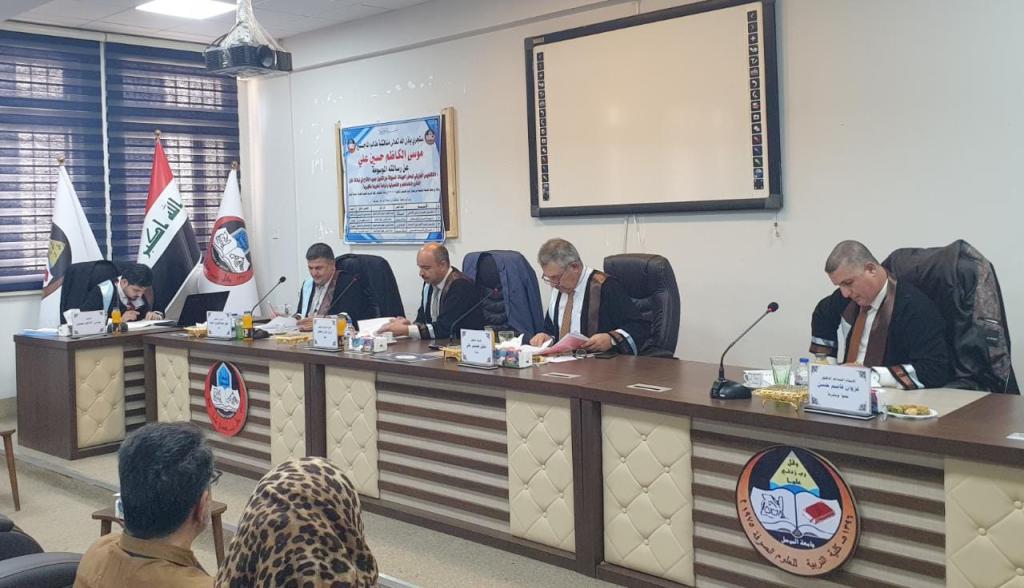15 September، 2022
Master Thesis Viva-Biology Department

Master Thesis Viva in the College of Education for Pure Science entitled ” Molecular diagnosis of some genes responsible for pollen grains formation in Solanum Lycopersicum, Arabidopsis thaliana, and study their phenotypic development “The College of Education for Pure Science, University of Mosul, has done the Master Thesis Viva entitled ” Molecular diagnosis of some genes responsible for pollen grains formation in Solanum Lycopersicum, Arabidopsis thaliana, and study their phenotypic development “,On Thursday, September 15, 2022, the respected Dean of the College, Assistant Professor Dr. Qais Ismail Ibrahim, the Honorable Scientific Associate and Administrative Associate, the Honorable Head of the Department of Biology, and a number of the college’s teachers were attended the viva. This study, presented by the M.Sc. Student Mousa-Alkadhim Hussein Ali in the Department of Biology, aimed to study pollen grain development in A. thaliana, P. vulgaris and S. lycopersicum and performing some molecular analysis for the relevant genes such as a polymerase chain reaction (PCR) assay, sequence alignments and phylogenetic analysis. Here, a series of wild type pollen was screened for their developmental stages in both A. thaliana and P. vulgaris and S. lycopersicum at unpolarized microspore (UMS), polarized microspore (PMS), early bicellular (EBC), mid bicellular (MBC), late bicellular (LBC), early tricellular (ETC), late tricellular (LTC) and mature pollen (MP). The results also showed that the pollen grains in A. thaliana have an oval to spherical shape, while the pollen grains in P. vulgaris have a spherical to triangular and tricolporate in shape, and the pollen grains in S. lycopersicum have oval shape.The molecular detection of Arabidopsis DUO1, HTR10 and GEX2 genes and their orthologs DUO1_PV, HTR10_PV and GEX2_PV in P. vulgaris and orthologs DUO1_SL و HTR10_SL و GEX2_SL in S. lycopersicum, were confirmed by a polymerase chain reaction technique. The Arabidopsis DUO1, HTR10 and GEX2 sequences showed a homology of 100%, 100% and 89% with deposited sequences in GenBank (Accessions: NM_115910.2, NM_101844.2, and AB743888.1) respectively, while the P. vulgaris gene sequences showed a homology of 82%, 99% and 98% with deposited sequences in GenBank (Accessions: CP039352.1, XM_007150332.1, and XM_007138871.1) respectively. While the DUO1, HTR10 and GEX2 S. lycopersicum gene sequences showed a homology of 85%, 99% and 98.52% with deposited sequences in GenBank (Accessions: HG9755133..1, XM_019215441.2 and XM_010323123.3) respectively.Multiple sequence alignments and phylogenetic evolutionary relationship were accomplished for current sequences by MEGA X_10.2.6 software. In general, the results showed a similarity to some extent between the current sequences with some deposited sequences in GenBank, and there is also a genetic relationship between them. The current study was focused on the importance of microspore polarity and asymmetric cell division of microspore for pollen development, as well as the molecular confirmation of some genes associated with this process.The Viva committee was chaired by Prof. Dr. Aqil Hussein Ali Al-Assi alkitab University Medical Technical College and the membership of Asst. Prof. Dr. Ryan Mazen Faisal University Of Mosul College Of Science, Lecturer Dr. Omar Abdel Aziz Ahmed University Of Mosul College of Education for Pure Science and under the supervision and membership of Asst. Prof. Dr. Ghazwan Qasim Hasan / University of Mosul / College of Education for Pure Science.













